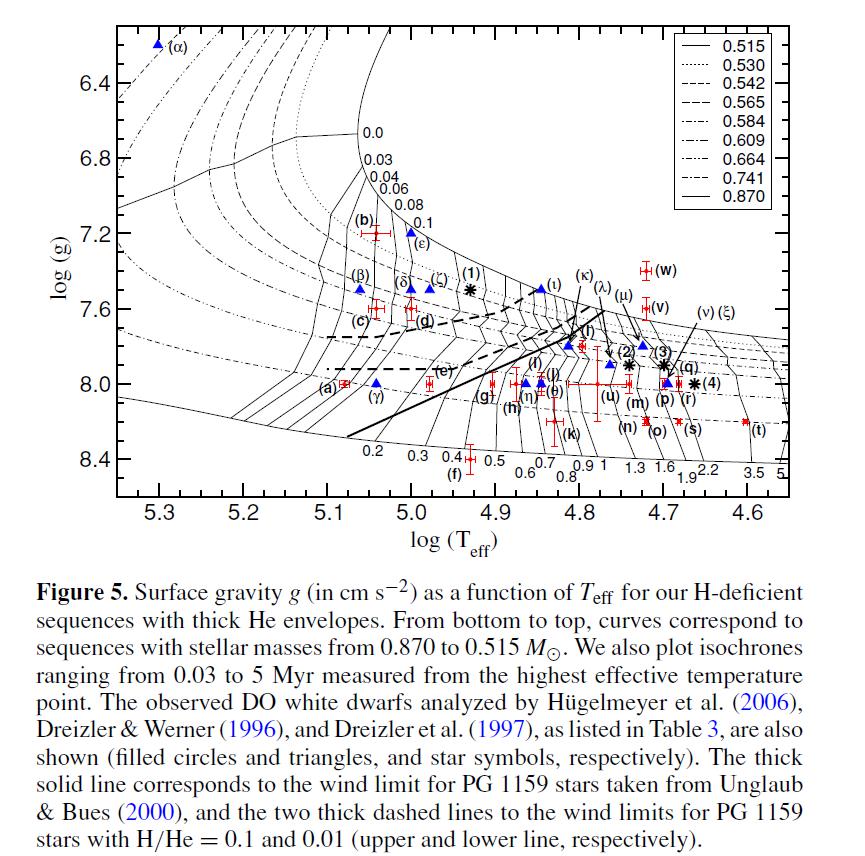Evolutionary
sequences appropriate for hot hydrogen-deficient white dwarfs, and
described in Althaus,
Panei, Miller Bertolami et al. 2009, ApJ, 704, 1605, are
provided. Calculations have been done with the stellar evolutionary
code LPCODE
developed at University
of La Plata,
Argentina. Details about LPCODE can be found at: Althaus,
Serenelli, Panei et al. 2005, A&A, 435, 631; Althaus,
Corsico, Bischoff-Kim et al. 2010, ApJ, 717, 897, and
references therein. Evolutionary sequences are computed
selfconsistently from progenitor stars evolved from the ZAMS through
the core hydrogen- and helium-burning evolutionary phases to the
thermally pulsing AGB and, ultimately, to the born again episode that
is responsible for the hydrogen deficiency. These calculations
provide a homogeneous set of evolutionary tracks appropriate for mass
and age determinations for both PG 1159 stars and DO-DB white dwarfs.
White dwarf sequences are computed in a consistent way with the
evolution of chemical abundance distribution caused by element
diffusion along the whole cooling phase. Calculations are extended
down to an effective temperature of 7000 K. The full treatment of the
entire evolutionary history of white dwarfs provides consistent white
dwarf initial configurations. In addition, our calculations also
yield self-consistent interior chemical profiles (click
here to download the chemical profiles of our hydrogen-deficient
white dwarf models).
Also,
colors and magnitudes for these sequences are provided for effective
temperatures less than 50,000K. They are based on
non-gray
local thermodynamic equilibrium (LTE) model atmospheres (Rohrmann
et al. 2002
).
The calculations were done for a pure helium composition and for
the HST ACS
filters (Vega-mag system) and UBVRI photometry.
The
initial models for our white dwarf sequences correspond to realistic
hydrogen-deficient PG 1159 stellar configurations derived from the
full evolutionary calculations of their progenitor stars for solar
metallicity (Miller
Bertolami & Althaus 2006
).
Each cooling sequence file lists from left to right:
|
Log
L: The logarithm of the surface luminosity in solar unit;
|
|
Log
Teff: The logarithm of the effective temperature (K);
|
|
Log
Tc: The logarithm of the central temperature (K);
|
|
Log
rho_c: The logarithm of the central density (gr/cm3);
|
|
12Cc:
Central abundance by mass of carbon
|
|
16Oc:
Central abundance by mass of oxygen
|
|
Age/Myr:
Cooling age in 106 years counted from the stage of
maximum effective temperature;
|
|
Log
LHe: The logarithm of luminosity (in solar unit) due to helium
burning;
|
|
Log
Lnu: The logarithm of luminosity (in solar unit) due to neutrino
losses;
|
|
Log(grav):
The logarithm of surface gravity (cm/s2);
|
|
R/R_sun:
Stellar radius en solar unit.
|
The
table below lists the H-deficient white dwarf sequences considered.
Additional sequences are provided upon request to Leandro Althaus at
althaus@fcaglp.unlp.edu.ar

Note:
For the 1Msun model,
two different sequences were computed with two different mass loss
rates during the AGB evolution. In this way, we obtain a different
number of thermal pulses and, in the end, two different remnant
masses of 0.530 and 0. 542 Msun,
respectively.
Our
evolutionary sequences in the plane surface gravity-effective
temperature together with observational data of DO white dwarfs are
shown in the figure below


